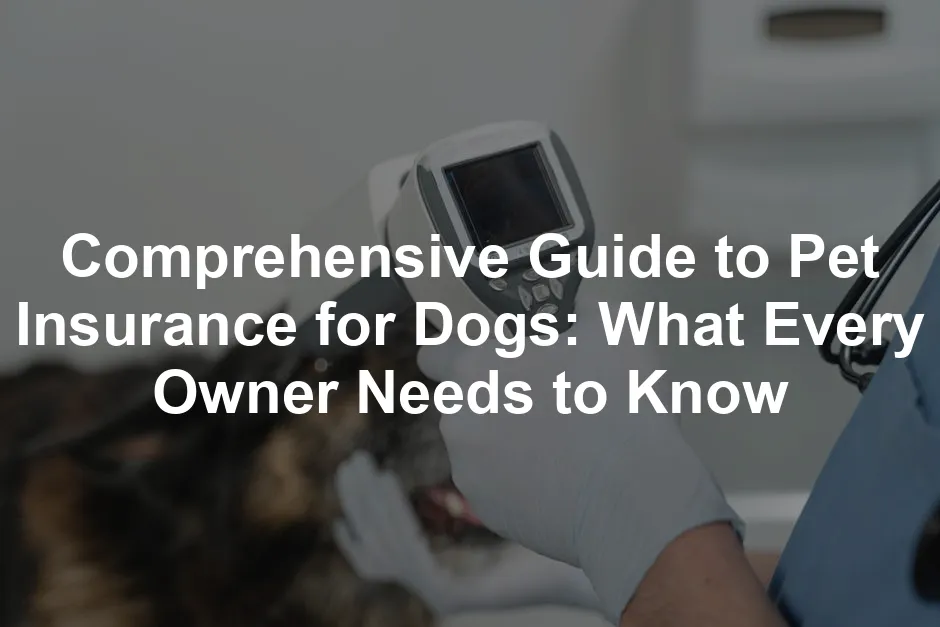Introduction
Are you a proud dog owner? If so, you know how much joy our furry friends bring. But have you considered the rising veterinary costs? Pet insurance for dogs can offer significant financial protection. It helps cover unexpected medical expenses that can quickly add up.
This article aims to inform you about dog insurance, its types, benefits, and important considerations. Let’s get started!
Summary and Overview
Pet insurance is a financial safety net for your canine companion. It covers various medical expenses, from routine check-ups to emergency surgeries. As veterinary bills continue to rise, having insurance is more relevant than ever.
There are several types of pet insurance available specifically for dogs. These include comprehensive health insurance and surgical coverage. Each type offers different benefits tailored to your dog’s needs.
Having pet insurance not only provides peace of mind but also ensures financial security. This coverage allows you to focus on your dog’s health without stressing about costs. In this article, we will cover coverage details, eligibility, and common exclusions.

Speaking of keeping your dog healthy, wouldn’t it be great to have a Pet First Aid Kit handy? You never know when your furry friend might get into a little mischief, and being prepared can save the day!
Understanding Pet Insurance for Dogs
What is Pet Insurance?
Pet insurance is a contract between you and an insurance provider. It helps cover the costs of your dog’s medical care. When you enroll, you pay monthly premiums. In return, the insurer covers a portion of your vet bills.
Premiums vary based on several factors, such as your dog’s age and breed. Most plans include deductibles, which are the amounts you pay out-of-pocket before coverage kicks in. Once your deductible is met, the insurer reimburses you for eligible expenses.
More dog owners are opting for pet insurance as awareness grows. It’s a smart choice that can save you money and ensure quality care for your beloved pet.

And speaking of pet care, have you ever thought about how much easier life would be with an Interactive Dog Puzzle Toy? Not only will it keep your pup entertained, but it also helps stimulate their mind—perfect for those rainy days when outdoor play isn’t an option!
Types of Pet Insurance Available
Health Insurance
Health insurance covers a wide range of veterinary services. This includes routine check-ups, vaccinations, and treatment for illnesses. It provides invaluable support when unexpected health issues arise. With this coverage, you can take your dog to the vet without worrying about the costs. Many plans also include preventive care options, helping ensure your dog stays healthy.

Surgery Insurance
Surgery insurance focuses specifically on surgical procedures. It covers the costs associated with necessary surgeries, including anesthesia and post-operative care. If your dog needs surgery, this insurance can alleviate financial stress. This type of coverage often has lower premiums compared to comprehensive health insurance. It’s a good option for pet owners primarily concerned about surgical costs.
Liability Insurance
Liability insurance protects against damages caused by your dog. If your pet injures someone or damages property, this insurance covers the costs. It’s essential for dog owners, especially in areas where certain breeds are considered dangerous. This insurance can save you from hefty bills resulting from accidents. Consider this coverage to safeguard your finances while enjoying dog ownership.

Speaking of safeguarding your finances, you might want to check out a Dog Travel Bag. It makes traveling with your pooch a breeze and ensures you have everything you need for a fun day out!
Why Get Pet Insurance?
Pet insurance offers several benefits that can greatly enhance your experience as a dog owner.
First, it covers unexpected veterinary bills. Pets can get sick or injured at any time. With insurance, you won’t have to make tough decisions based on cost alone.
Second, it provides access to quality veterinary care without financial stress. You can focus on your dog’s health rather than worrying about expenses.
Finally, many plans are customizable based on individual needs. You can choose coverage levels, deductibles, and add-ons that fit your budget. This flexibility ensures that you find a plan that works for you and your furry friend.

Coverage Details
What Does Pet Insurance Cover?
Pet insurance typically covers several common areas of veterinary care.
First, it includes veterinary consultations and treatments. You can visit the vet for regular check-ups or when your dog is unwell.
Second, surgical procedures are covered, including anesthesia and post-operative care. This coverage ensures you don’t face hefty bills if your dog needs surgery.
Lastly, pet insurance often covers prescription medications and diagnostic tests. This includes essential treatments that can help your dog recover faster.

Understanding these coverage details is crucial for making informed decisions about the right insurance for your dog.
And while you’re at it, consider investing in a Dog Grooming Kit. Keeping your dog well-groomed can help prevent health issues and ensure they look their best!
Exclusions and Limitations
When considering pet insurance for your dog, it’s crucial to understand typical exclusions and limitations. Most policies won’t cover pre-existing conditions, meaning any health issues your dog had before enrollment. This can include chronic illnesses or injuries. It’s essential to read the fine print to know what is and isn’t covered.
Routine care is another area often excluded. Regular check-ups, vaccinations, and dental cleanings may not qualify for reimbursement. However, emergency care usually is covered, which is vital for unexpected incidents.
Additionally, some breed-related health issues may not be covered. Certain breeds are prone to specific conditions, and insurers might exclude these from coverage. Always verify the specifics of your policy to avoid surprises.

Waiting Periods
Waiting periods are the time frames before your coverage begins. Most insurers have waiting periods, often ranging from a few days to several weeks. During this time, new health issues are typically not covered.
For example, accidents might have a shorter waiting period, while illnesses may require a longer wait before coverage kicks in. Each insurance provider sets its own rules, so it’s essential to check with your chosen provider. Understanding these details can help you plan accordingly for your pet’s healthcare needs.

Choosing the Right Plan
Factors to Consider When Selecting Insurance
Choosing the right pet insurance plan can feel overwhelming. Start by considering your dog’s age and breed. Older dogs might have higher premiums due to increased health risks.
Next, look at coverage limits and deductibles. Higher coverage limits usually mean higher premiums, but they can save you money in emergencies. Evaluate what you can comfortably afford each month.
Lastly, consider monthly premiums and overall costs. It’s crucial to find a balance between affordability and adequate coverage. Look for plans that fit your budget while ensuring your dog receives the best possible care.

If you’re planning on taking your dog on adventures, a Dog Life Jacket is a must! Safety first, right?
Popular Pet Insurance Providers
Several reputable pet insurance providers cater to dog owners. For instance, Feather offers customizable plans with a focus on preventive care. Their coverage options are tailored to various needs and budgets.
Another option is Getsafe, known for its transparent conditions and digital platform for managing claims. They provide flexible plans and competitive pricing.
Comparing these providers can help you find the best fit for your furry friend. Look for coverage options, customer reviews, and pricing structures to make an informed decision.

Costs of Pet Insurance
Average Costs and Factors Influencing Pricing
Pet insurance can vary widely in cost. On average, dog owners pay between $30 to $70 monthly for coverage. However, several factors influence these premiums.
First, your dog’s breed plays a significant role. Certain breeds are prone to specific health issues, which can raise costs. For example, bulldogs may have higher premiums due to their common health problems.
Age is another crucial factor. Older dogs often incur higher premiums as they are more susceptible to health issues. If your dog is a senior, expect to pay more.
Location also matters. Veterinary costs vary by region, affecting insurance rates. Urban areas typically have higher costs due to increased competition among clinics and specialists.

Budgeting for Pet Insurance
Budgeting for pet insurance is essential. Start by assessing your monthly expenses. Set aside a specific amount each month for insurance premiums. This way, you won’t be caught off guard by unexpected costs.
Consider potential discounts. Many insurers offer savings for insuring multiple pets. If you have more than one dog, this option can significantly reduce your total costs.
Don’t overlook preventive care discounts. Some plans provide lower premiums if you include preventive care in your policy. Regular check-ups and vaccinations can be more affordable with this approach.

Claims Process
How to File a Claim
Filing a claim is straightforward. Start by reviewing your insurance policy to understand what’s covered. Keep all relevant documents handy, including receipts and treatment records.
Next, complete the claim form provided by your insurer. Be clear and concise when detailing the treatment. Submit your claim along with the necessary documentation. Remember, timely submissions can speed up the reimbursement process.
Maintaining organized records is crucial. Keep copies of all receipts and documents related to your dog’s care. This practice ensures you have everything needed for a successful claim.

Common Issues with Claims
While filing claims is generally simple, issues can arise. One common pitfall is not understanding policy exclusions. Always read your policy carefully to avoid surprises.
Another frequent mistake is missing documentation. Incomplete claims can delay processing. Always double-check that you’ve included all required paperwork.
To avoid these issues, take your time when filing claims. Review your documents and ensure that everything is correct before submission. This extra step can save you time and frustration down the line.

Conclusion
Pet insurance is crucial for dog owners. It provides financial protection against unexpected veterinary costs. With rising medical expenses, having insurance ensures you can afford necessary treatments. This peace of mind allows you to focus on your dog’s health without financial worries.
Take a moment to assess your pet’s needs. Consider factors like age, breed, and health history. Each dog is unique, so tailor your insurance choice accordingly.
Don’t hesitate to compare different policies. Reach out to multiple providers for quotes. This way, you can find the best coverage for your furry friend.

Also, if your dog is prone to anxiety, consider a Dog Anxiety Vest. It can help calm your pup during stressful situations, making life easier for both of you!
FAQs
What is the average cost of pet insurance for dogs?
The average cost ranges from $30 to $70 monthly. Prices depend on factors like breed, age, and location.
Are pre-existing conditions covered by pet insurance?
Generally, pet insurance does not cover pre-existing conditions. Most providers have strict policies regarding previously diagnosed issues.
Can I get pet insurance for a senior dog?
Yes, but options may be limited. Some insurers may impose age restrictions or higher premiums for older dogs.
What happens if my dog needs emergency care?
Pet insurance can help cover emergency expenses. This includes visits to the vet for urgent health issues.
How do I choose the best pet insurance for my dog?
Compare different insurance plans. Look for coverage limits, deductibles, and monthly premiums. Consider your dog’s specific health needs for the best fit.
Please let us know what you think about our content by leaving a comment down below!
Thank you for reading till here 🙂
All images from Pexels





